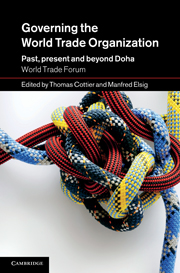1 - Introduction
Published online by Cambridge University Press: 07 September 2011
Summary
Constitutional paralysis paved the way for financial ruin, for military impotence, and for foreign invasion. If taxes could not be raised, the Republic's Army could not be maintained, and the Republic's enemy could do as they pleased.
(Davies 2001)The World Trade Organization (WTO) stands at a crossroads, a situation it shares with many other international organisations (IOs) established after the Second World War. While challenges from globalisation are creating opportunities and the need for enhanced multilateral cooperation, IOs have largely remained on the sidelines, staying with structures shaped for a different and past period. The responses to the most recent financial, fiscal and economic crises and the failure to reach more than a shaky political accord at the 2010 Copenhagen Summit on Climate Change illustrate two facts: the absence of leadership and the preference for unilateral, bilateral or plurilateral approaches, and the lack of an appropriate international architecture able to deal with a highly complex international agenda. Nation states continue to cling to an outdated model of Westphalian sovereignty which translates into limited delegation to and within IOs of global reach. The exact diagnosis of shortcomings and crises varies from one IO to another. In the case of the WTO – formally created in 1995 but strongly building upon the experience and diplomatic modus operandi of the 1947 General Agreement on Tariffs and Trade (GATT) – an obvious imbalance between the organisation's modern dispute settlement arm and its traditional negotiation platform emerged (Cottier and Takenoshita 2003).
- Type
- Chapter
- Information
- Governing the World Trade OrganizationPast, Present and Beyond Doha, pp. 1 - 10Publisher: Cambridge University PressPrint publication year: 2011



